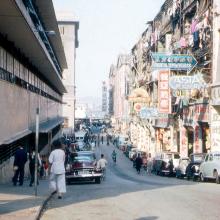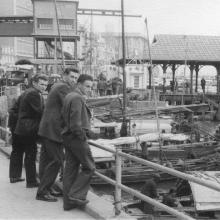The photograph is now the right way round!
Central, Connaught Road and Law courts
Primary tabs

Submitted by Andrew Suddaby
Date picture taken (may be approximate):
Wednesday, January 1, 1958
Gallery:
Connections:
- Central, Connaught Road and Law courts shows Place Supreme Court Building / Legislative Council Building [1910- ]
- Central, Connaught Road and Law courts shows Place Old Bank of China Building [1951- ]




Comments
Re: Photo
The photo needs to be horizontally flipped.
Thanks for pointing this out.
Thanks for pointing this out. It's been the wrong way round on my computer for years!
Andrew
Excellent Photo Archive of Late 1950s Hong Kong
Hello Andrew,
Every single cent that you spent on creating all these great pictures turned into a gold nugget after all these years. Each and every photo in your collection has immense value to the viewers. When you were posted to Little Sai Wan I was a small neighbor living in the nearby Shaukiwan which was just a cluster of small buildings along the tram track at the lower end of the steep Island Road. Your shots of Chaiwan taken from the Cape Collinson Road bought back to me the fun of my family swimming in that small beach under the Boy's Scout Camp before the reclamation started. The RAF Sai Wan Station was always a mystery to us as we small kids were not told its functions. We could only peer into it from the top of Cape Collinson after tackling the long and winding road from Chaiwan.
In view of the boundless historical values of your photos I would request the Librarian of the University of Hong Kong to duplicate a set of them for its special Hong Kong Collections. Look forward to seeing more nostalgic pictures from you soon.
Tai Wong from Mississauga, Canada.
Hello Tai Wong
Hello Tai Wong
How kind of you to respond so positively to seeing my old photogrpahs. Rather than commenting twice I shall reply to both your comments here. There is another set of my photographs (1980s) that is now almost completed. They were taken on a holiday that my wife and I had in 1981. I also had another trip to Hong Kong in 1987, basically to have a last walk round the old R.A.F. camp at Little Sai Wan before the bulldozers moved in. All being well I shall upload some more photographs from that year, although I am not sure how many of them David wants. I don't want to flood his site with photographs that, while nostalgic for me, might not be of a wide enough general interest. Shau Kei Wan is certainly a very different place
In the years between 2001 and 2007 I made annual trips back for six or seven nights largely to explore as many of the battlesites from the war as I could. A superb book, Ruins of War, by Ko Tim Keung was my main guide. Tim, and another friend Rob, who also contributes to David's site, were especially helpful in helping me, via emails, to find the places that I looked for. By 2007 I'd visited all the places that were still accessible so I called it a day. It was proving to be rather an expensive indulgence! Of course, I also always went to Siu Sai Wan and sat on what I called the sun-bathing rocks round the Point, had a small picnic there, and enjoyed my own bit of nostalgia for my youth - but I never had a swim there, opting for the long walk over to Big Wave Bay to do that.
Some time around 2005 I did put together an audio visual 'then and now' 'film' and, when I have finished the still images for 1981 and 87, I shall discuss with David how best to transfer this to his site. A year or so ago, I gave all my colour slides to Tim so that they would have a good home, where they really belong, in Hong Kong. He also has a DVD with those and also copies of most of my black and white images on it. What he chooses to do with them in the long run is up to him but I feel confident that Tim will eventually pass them on to a worthwile body. The problem with donating images to museums is (in my experience of the U.K.) that they like to acquire copyright in them - with the uncertainty that they might start to sell copies and that is not what I really want to happen in my lifetime. I want people, as individuals, to be able to share in and hopefully to enjoy what I managed to photograph. I would not want my old photographs to be turned into an organisation's profit.
Since 1958, I have occasionally wondered what became of some of the children we chatted to (neither really speaking the other's language) and to whom we gave sweets and bananas. That would not be allowed these days! The Cape Collinson lighthouse keeper (it used to be manned) had two or three young sons and I speculated whether they might have ended up in England - perhaps even owning one of the Chinese restaurants that my family have been to. You have partly answered that! Canada must be a great place to live, very different to either the Hong Kong of your childhood or even as it is now.
My very best wishes
Andrew
Depository of Valuable Archives
Hello Andrew,
Thank you very much for telling me where and when to look for your other treasures. AS I am a history graduate of HKU I know that its Hong Kong Collections is a fine and reliable depository of archival materials related to Hong Kong. The University's Main Library also has a special Hankow Collection for rare books on China and Hong Kong. These two collections are for reference only and the users are not allowed to borrow. Some of the materials are not even allowed to be photocopied or photographed.to ensure the copyrights are not abused.
You may contact the Librarian of HKU by email and I am sure he/she will be very happy to discuss with you about donation and copyright issues.
Every single picture of yours has a lot of meanings depending on the background and use of the viewers. For example the apparently simple one of showing you or your buddies walking up the steep Collinson Cape Road reminds me of struggling on the same location more than 55 or 60 years ago. The others showing your group at The Point have special values for social history. The viewers may ask why was there no pretty English and Chinese girls around ? Was sunbathing or swimming apart from soccer the only leisure available to these young men ? The same pictures can also be used for geography study to compare the physical changes that have been made to the shoreline since the pictures were taken. So please give ALL your pictures to David or academic institutes of HK where they deserve to preserve the history of HK.
Tai Wong
Thanks Tai Wong
Thanks Tai Wong
Each time I re-visited Little Sai Wan/SIu Sai Wan I walked up the old camp road. Since 2000 it's been a well maintained path with lots of street lights. Many people living in the huge blocks of flats down in what was the bay use that path for exercise. Sometimes when I've been taking photographs or videos there, people havel looked at me, obviously wondering what an old Gweilo is doing there, miles away from the tourist spots. I always resisted tellng them that I, too, once lived there. However, having as usual scrambled across the rocks from the Promenade to our sunbathing rocks, I once met a group of school boys. I showed them a copy of the photograph of me and my pals sitting on the same spot in1958, pointing to myself on it. I think that they found it hard to believe that it was me and that I had come all the way from England to be there! I was pleased when most of them agreed to pose for a now and then photograph. One day that should find its way onto David's site - maybe in a slide show with the images fading from one time to another. Before that, I shall finish off a few from 1981 and then move on to 1987.
In answer to your question, spare time at Little Sai Wan was limited. We often sat on the balcony outsde our room looking out across the bay and sea towards Lye Mun, just admiring the wonderful view and watching ships, junks, sampans and planes moving across the sea and sky in front of us. Swimming and sunbathing were popular if the weather was good - usually round the Point but also, after the long trek over the hill, at Big Wave Bay. Shek O and occasionally Repulse Bay depended on being able to get a ticket for the run on an R.A.F. bus or lorry. These were not every day but depended on the availability of drivers and the weather. Of course, visits 'down town' were popular and sometimes, if I had more time, I took the train or buses into the New Territorioes, where the only places that I managed to visit were Shatin, Taipo Market, Yuen Long and Kam Tin. I also visited Cheung Chau and Macau and that was it. If only I'd known how much things were going to change! Life in the R.A.F. was very much male orientated. Apart from the amahs who looked after us so well - and kept us in order! - the only woman who we had any contact with on the camp was a lovely W.V.S.lady called Thea who came several evenings a week to organise games, quizes and competitions in the N.A.A.F.I. She was a bit like a surrogate 'Mum' to us. I recall one occasion when she asked me when my mother's birthday was. I replied that it was coming up soon. "Have you got her a card yet?" Admitting that I hadn't the response was "Well, that will NEVER do." A day later she returned with a selection for me to choose from. How thoughtful.
Regards Andrew